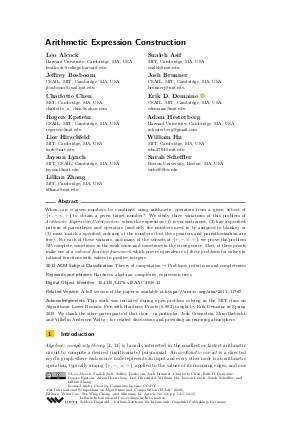Arithmetic Expression Construction
Authors
Leo Alcock,
Sualeh Asif,
Jeffrey Bosboom,
Josh Brunner,
Charlotte Chen,
Erik D. Demaine  ,
Rogers Epstein,
Adam Hesterberg,
Lior Hirschfeld,
William Hu,
Jayson Lynch,
Sarah Scheffler,
Lillian Zhang
,
Rogers Epstein,
Adam Hesterberg,
Lior Hirschfeld,
William Hu,
Jayson Lynch,
Sarah Scheffler,
Lillian Zhang
-
Part of:
Volume:
31st International Symposium on Algorithms and Computation (ISAAC 2020)
Part of: Series: Leibniz International Proceedings in Informatics (LIPIcs)
Part of: Conference: International Symposium on Algorithms and Computation (ISAAC) - License:
 Creative Commons Attribution 3.0 Unported license
Creative Commons Attribution 3.0 Unported license
- Publication Date: 2020-12-04
File

PDF
LIPIcs.ISAAC.2020.12.pdf
- Filesize: 0.57 MB
- 15 pages
Document Identifiers
Related Versions
-
A full version of the paper is available at https://arxiv.org/abs/2011.11767.
Subject Classification
ACM Subject Classification
- Theory of computation → Problems, reductions and completeness
Keywords
- Hardness
- algebraic complexity
- expression trees
Metrics
- Access Statistics
-
Total Accesses (updated on a weekly basis)
0Document
0Metadata
Abstract
When can n given numbers be combined using arithmetic operators from a given subset of {+,-,×,÷} to obtain a given target number? We study three variations of this problem of Arithmetic Expression Construction: when the expression
(1) is unconstrained;
(2) has a specified pattern of parentheses and operators (and only the numbers need to be assigned to blanks); or
(3) must match a specified ordering of the numbers (but the operators and parenthesization are free).
For each of these variants, and many of the subsets of {+,-,×,÷}, we prove the problem NP-complete, sometimes in the weak sense and sometimes in the strong sense. Most of these proofs make use of a rational function framework which proves equivalence of these problems for values in rational functions with values in positive integers.
Cite As Get BibTex
Leo Alcock, Sualeh Asif, Jeffrey Bosboom, Josh Brunner, Charlotte Chen, Erik D. Demaine, Rogers Epstein, Adam Hesterberg, Lior Hirschfeld, William Hu, Jayson Lynch, Sarah Scheffler, and Lillian Zhang. Arithmetic Expression Construction. In 31st International Symposium on Algorithms and Computation (ISAAC 2020). Leibniz International Proceedings in Informatics (LIPIcs), Volume 181, pp. 12:1-12:15, Schloss Dagstuhl – Leibniz-Zentrum für Informatik (2020)
https://doi.org/10.4230/LIPIcs.ISAAC.2020.12
BibTex
@InProceedings{alcock_et_al:LIPIcs.ISAAC.2020.12,
author = {Alcock, Leo and Asif, Sualeh and Bosboom, Jeffrey and Brunner, Josh and Chen, Charlotte and Demaine, Erik D. and Epstein, Rogers and Hesterberg, Adam and Hirschfeld, Lior and Hu, William and Lynch, Jayson and Scheffler, Sarah and Zhang, Lillian},
title = {{Arithmetic Expression Construction}},
booktitle = {31st International Symposium on Algorithms and Computation (ISAAC 2020)},
pages = {12:1--12:15},
series = {Leibniz International Proceedings in Informatics (LIPIcs)},
ISBN = {978-3-95977-173-3},
ISSN = {1868-8969},
year = {2020},
volume = {181},
editor = {Cao, Yixin and Cheng, Siu-Wing and Li, Minming},
publisher = {Schloss Dagstuhl -- Leibniz-Zentrum f{\"u}r Informatik},
address = {Dagstuhl, Germany},
URL = {https://drops.dagstuhl.de/entities/document/10.4230/LIPIcs.ISAAC.2020.12},
URN = {urn:nbn:de:0030-drops-133568},
doi = {10.4230/LIPIcs.ISAAC.2020.12},
annote = {Keywords: Hardness, algebraic complexity, expression trees}
}
Author Details
Acknowledgements
This work was initiated during open problem solving in the MIT class on Algorithmic Lower Bounds: Fun with Hardness Proofs (6.892) taught by Erik Demaine in Spring 2019. We thank the other participants of that class - in particular, Josh Gruenstein, Mirai Ikebuchi, and Vilhelm Andersen Woltz - for related discussions and providing an inspiring atmosphere.
References
-
Divesh Aggarwal and Ueli Maurer. Breaking RSA generically is equivalent to factoring. In Antoine Joux, editor, Advances in Cryptology - EUROCRYPT 2009, pages 36-53, Berlin, Heidelberg, 2009. Springer Berlin Heidelberg.

-
Sanjeev Arora and Boaz Barak. Computational Complexity: A Modern Approach. Cambridge University Press, USA, 2009.

-
David Buchfuhrer and Christopher Umans. The complexity of boolean formula minimization. In Luca Aceto, Ivan Damgard, Leslie Ann Goldberg, Magnús M. Halldórsson, Anna Ingólfsdóttir, and Igor Walukiewicz, editors, Automata, Languages and Programming, pages 24-35, Berlin, Heidelberg, 2008. Springer Berlin Heidelberg.

- E. W. Dijkstra. ALGOL-60 translation. Technical Report MR 34/61, Rekenafdeling, Stichting Mathematisch Centrum, 1961. URL: https://ir.cwi.nl/pub/9251.
-
Peter Downey, Benton Leong, and Ravi Sethi. Computing sequences with addition chains. SIAM Journal on Computing, 10(3):638-646, 1981.

-
Michael R. Garey and David S. Johnson. Computers and Intractability. W. H. Freeman and Company, New York, 2002.

-
Daniel M. Gordon. A survey of fast exponentiation methods. Journal of Algorithms, 27:129-146, 1998.

-
Edith Hemaspaandra and Henning Schnoor. Minimization for generalized boolean formulas. arXiv:1104.2312, 2011.

-
Valentine Kabanets and Jin yi Cai. Circuit minimization problem. In Proceedings of the 32nd Annual ACM Symposium on Theory of Computing, pages 73-79, Portland, OR, 2000.

-
Ueli Maurer. Abstract models of computation in cryptography. In Nigel P. Smart, editor, Cryptography and Coding, pages 1-12, Berlin, Heidelberg, 2005. Springer Berlin Heidelberg.

- C. T. Ng, M. S. Barketau, T. C. E. Cheng, and Mikhail Y. Kovalyov. "Product Partition" and related problems of scheduling and systems reliability: Computational complexity and approximation. European Journal of Operational Research, 207(2):601-604, 2010. URL: https://doi.org/10.1016/j.ejor.2010.05.034.
-
Arnold Scholz. Aufgaben und Lösungen 253. Jahresbericht der Deutschen Mathematiker-Vereinigung, 47:41-42, 1937.

-
Victor Shoup. Lower bounds for discrete logarithms and related problems. In Walter Fumy, editor, Advances in Cryptology - EUROCRYPT '97, pages 256-266, Berlin, Heidelberg, 1997. Springer Berlin Heidelberg.

-
Joachim von zur Gathen. Algebraic complexity theory. In Annual Review of Computer Science, volume 3, pages 317-347. Annual Reviews Inc., 1988.

- Wikipedia. 24 game. URL: https://en.wikipedia.org/wiki/24_Game.
